So yeah I'm having way too much fun ranting about Magic theory
Advanced Principal: The Hows and Whys Magic the Gathering's Metagame
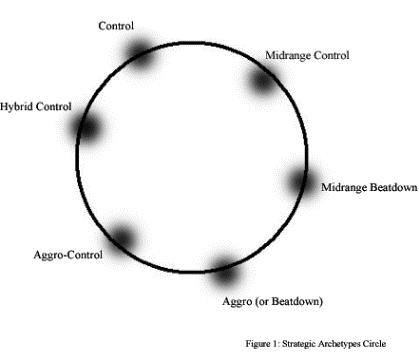 we'll get back to this thing later
we'll get back to this thing later
So going back to those previous unhealthy metas I talked about people didn't just dislike them because one deck because too dominant but because they were fundamentally unlike the Magic they were used too. For instance lets compare some traditional threats in Magic to some traditional answers of equivalent cost.
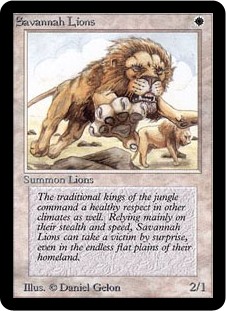
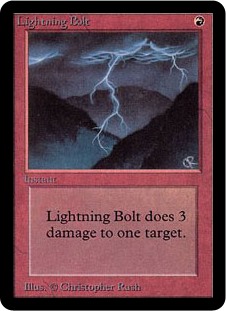
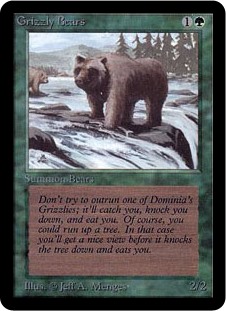
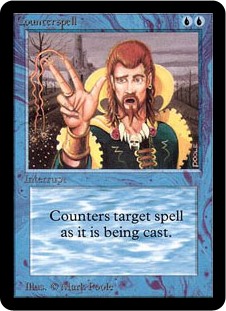
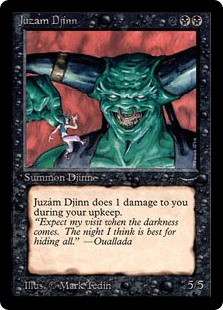

As we can see for 1 mana threat the best you're getting is a Savanah Lions and it's 2 points of power and with a few exceptions that largely held steady to this day. For your one mana answer you get lightning bolt which not only kills their lions any other one drop they'er backing it's very frequently going to bring down even bigger targets. While you get better 2 drops even in those days the fact of the matter is then any now any single threat can be nixed for 2 mana. A 4 mana threat got you Juzam Djinn and these days it'll get you a 5/5 with upside but at 4 man Wrath didn't just kill the Djinn it kills any friends he might have brought with him.
The traditional Magic metagame is defined this advantage answers have over threats. This is what makes control and aggro the traditional poles the format. When the threats are more powerful than the answers Magic lurches onto alien ground. However in a traditional Magic metagame you have aggro decks anchoring one end of the spectrum and control deck anchoring the other (the place of Combo decks in there is sort complicated so I'm going to be glossing over it for now). The theory of deckbuilding in Magic is all about those archatypes, the interplay between them, and the various shades in between.
Taking Control
The Deck- Brian Weissman
1 Ancestral Recall
1 Time Walk
1 Amnesia
4 Mana Drain
2 Counterspell
1 Braingeyser
1 Timetwister
1 Recall
4 Swords to Plowshares
4 Disenchant
2 Moat
2 Serra Angel
2 Red Elemental Blast
1 Demonic Tutor
1 Regrowth
1 Mirror Universe
1 Jayemdae Tome
2 Disrupting Scepter
1 Black Lotus
1 Sol Ring
1 Mox Sapphire
1 Mox Jet
1 Mox Ruby
1 Mox Emerald
1 Mox Pearl
3 Strip Mine
1 Library of Alexandria
4 City of Brass
4 Tundra
2 Volcanic Island
4 Island
3 Plains
Sideboard
2 Blood Moon
2 Red Elemental Blast
2 Circle of Protection: Red
2 Dust to Dust
2 Mana Short
1 Balance
1 Amnesia
1 Feldon’s Cane
1 Tormod’s Crypt
1 Zuran Orb
This is "The Deck" by Brian Weissman it's generally regarded as the first serious tournament deck or at the very least the first deck built on Magic theory as we know it today. It was the first control deck and like the decks that would follow it it was principally concerned with defense and card advantage. The relative efficiency of answers to threats is central the Decks ability because being solely concerned with answering its' opponents plays the Deck generated a tempo advantage which it would spend on drawing more cards/making it's opponent discard. What Weissman was the first to realize is that if you do this you will eventually end up in complete control of the game and after that actually winning is a formality. Weissman is generally credited with inventing the concept of card advantage both by drawing extra cards and by exchanging a smaller number his cards for a larger number of his opponents. He also cemented another great control tradition of having whatever card you're using to win the game pull double duty as a defensive tool, as Serra Angel also protected Weissmans life total against whatever was flying over his Moats.
The control decks that would arise in various standards would be much more concerned about creatures than Weissman partly because creatures got better but partly because the aggressive decks tightened up their game. While the Deck had Moats too negate all opposing ground-pounders most of the decks that followed would often need cards like Wrath of God to acquire the necessary tempo and card advantage to take control of the game. Obviously though even more heavily associated with control as an archetype is the color Blue with some of the most versatile answers in the form of counterspells and the ability to just draw extra cards with no fussing about.
Despite control decks essentially having an advantage baked into the game itself it's rare for control to truly dominate a metagame. This because by focusing on answers they concede the first move to the enemy, and actually games are messy affairs. A wise man once said there are no wrong threats only wrong answers, if you purely reactive deck draws the wrong answers they just lose.
Learning Aggression
There have been decks solely concerned with playing creatures and turning them sideways since the dawn of magic. There were evens some early stand outs like the Zoo decks but the aggro as an archetype was really codified by Paul Sligh.
Orcish Librarian Deck-Paul Sligh
23 creatures
2 Dragon Whelp
2 Brothers of Fire
2 Orcish Artillery
2 Orcish Cannoneers
4 Ironclaw Orcs
3 Dwarven Lieutenant
2 Orcish Librarian
4 Brass Man
2 Dwarven Trader
2 Goblin of the Flarg
14 spells
1 Black Vise
1 Shatter
1 Detonate
4 Lightning Bolt
4 Incinerate
1 Fireball
1 Immolation
23 lands
4 Strip Mine
4 Mishra's Factory
2 Dwarven Ruins
13 Mountain
Sideboard
1 Shatter
1 Detonate
1 Fireball
1 Meekstone
1 Zuran Orb
3 Active Volcano
2 Serrated Arrows
1 An-Zerrin Ruins
4 Manabarbs
When this deck showed up it blew people minds because it's one thing to win tournaments with Kird Apes and Black Vices like the old Zoo decks but it's another thing entirely to win with Goblin of the flarg. Aggro pilots already knew that in order to succeed they need to be as fast and consistent as possible but for the first time there was a formula for doing that which independent of the cards that composed your deck. You see Paul had discovered the Mana curve and Aggro decks wouldn't quite be the same afterward.
By playing 8 one mana creatures, 9 two mana creatures and 6 three mana creatures Paul could play a 1 mana guy, a 2 mana guy a 3 mana guy in that order across the first three turns pretty much every game. That speed and efficiency made up for how much the individual creatures sucked. Eventually his initial rush would be stalled out by his opponent having answers or better creatures but at that point Paul could transition to being a burn deck and win that way. Those burn spells gave Paul what would later be called Reach the ability to get those last few points of damage through opposing blockers/answers. Because Red packs so many burn spells that can bring an early end to the game by going to the face aggro has a deep association with the color Red in the same way Control has a deep association with Blue (though not quite to the same extent)
To wheel things back to basics however a pure Aggro deck is concerned primarily with advancing it's own plan of attack as quickly as possible to the exclusion of all else. It has little interest in interacting with your opponent cards or reacting to what they are doing. It's for this reason that combo decks tend to be placed in the "aggro" part of that diagram that I started off this post with as combo decks usually make even fewer concession to the fact that their opponent has cards than aggro decks.
Ebb and flow
Where this all starts getting complicated is that few decks are pure aggro or pure control most decks will have a proactive plan but will also be playing reactive cards. These various composite archetypes between aggro and control on that wheel diagram are defined by commitment to an aggressive plan and what exactly their answers are for. Generally such composite decks use there more limited suite of answers to try to control time(tempo)
or card advantage. Unlike a control deck which controls both at the expense of a proactive plan or an aggro deck which is concerned with ending the game rather than controlling it.
For instance this is a Midrange deck
Necropotance-Leon Lindbeck
4 Hypnotic Specter
4 Order of Ebon Hand
3 Knight of Stromgald
4 Necropotence
4 Drain Life
1 Soul Burn
1 Dark Banishing
4 Hymn to Tourach
4 Dark Rituals
1 Dance of the Dead
1 Ivory Tower
1 Zuran Orb
1 Jalum Tome
2 Serrated Arrows
2 Nevinyrral’s Disk
4 Strip Mine
2 Ebon Stronghold
17 Swamps
Sideboard
1 City of Brass
1 Safe Haven
1 Feldon’s Cane
1 Meekstone
1 Apocalypse Chime
3 The Rack
1 Torture
1 Stromgald Cabal
1 Ashes to Ashes
1 Serrated Arrows
1 Jalum Tome
2 Nevinyrral’s Disk
This is one of the early Necropotance decks which would dominate standard in 1996. These decks weren't heavily concerned with drawing the game out or winning quickly despite playing some fairly aggressive creatures and one of the greatest card advantage engines in history. Like future midrange decks Necro is interested in controlling cards and uninterested in controlling time. A good example of this is Hymn to Torach it puts you ahead by one card but you spent 2 mana and didn't effect the board (so you lost out in tempo). Necro also verges a little into card efficiency side of the pool as well Necro plays pump knights not because it is particularly committed to an aggressive plan but because they were the best individual threats at the time.
Future Midrange decks would often get a bad rap for just being “a pile of good cards” but that's a little unfair. Midrange strategies want to maximize the value of their cards relative to your cards. Obviously this is achieved through straight 2 for one cards like Hym but this logic also extends to their threats. Unlike an aggro deck that's trying to kill you quickly through a critical mass of threats a midrange deck aims for each individual threat to do as much as possible. This is why as 3-5 mana creatures have gotten stronger midrange decks has become more common. Midrange decks share and fondness for inevitability with control they often win games by still having resources even after you've expended everything.
The flip side of the midrange strategy is the aggro-control deck and it's big siblings hybrid control and tap out control
Countersliver-Trey Van Cleave
4 Crystalline Sliver
4 Hibernation Sliver
4 Muscle Sliver
3 Winged Sliver
2 Acidic Sliver
4 Aura of Silence
4 Daze
4 Force of Will
3 Annul
2 Swords to Plowshares
3 Demonic Consultation
4 City of Brass
4 Tundra
4x Underground Sea
2x Scrubland
2 Gemstone Mine
1 Undiscovered Paradise
4 Flood Plain
1 Tropical Island
1 Volcanic Island
Sideboard:
4 Erase
2 Swords to Plowshares
4 Pyroblast
2 Hydroblast
3 Worship
Aggro-control and friends aren't interested in tempo advantage rather than card advantage. Unlike midrange or control these decks are unconcerned with inevitability they just want to extend the game just long enough. The classic Aggro-control deck like Countersliver wants to establish a superior board position and then deny your ability to interact with it until they win. Most often this is accomplished through the use of permission spells but a lot of the old Armageddon/Wildfire decks operated on similar principals. Establish a strong board position and then blow up all the lands so they couldn't do anything about it.
What distinguishes the decks on the left side of the spectrum is that they plan on “turning the corner”. the aggro, midrange and control plan to maintain one type of strategy for an indefinite period of time aggro control and hybrid control are going to do one thing for a few turns and then do something completely different. The aggro-control deck will play guys but once they have enough guys they'll start countering your spells. Closer to the control end of the spectrum is the hybrid control deck which adopts a defensive posture until they have amassed enough resources to excucute an aggressive plan. These decks had their heyday in the Ravnica era when 5-6 drops had finally gotten good enough that you could tap out for them and reasonably believe that was better than whatever your opponent was doing.
Welcome to Broken Magic land
Now all of these archetypes are based on the idea that answers are more powerful than threats, the control decks exploit it and the aggro decks try to route around it. However what happens when the reverse is true and threats outpace answers? Well then you enter broken magic land and the meta game becomes fundamentally different. Instead of this

you get this

When threats are better than answers there is no control deck. If you try to sit back on answers you just lose so you need to have some sort of proactive plan. So how do you beat an aggro deck if threats are better than answers? Well one obvious answer is be the better aggro deck. If you can goldfish faster than the rest of the field you don't need to answer anything. This is the rock to the face or “fast aggro”
Another answer is that you don't have to stop aggro just delay or disrupt it long enough to execute your own game winning maneuver. A set of answers that's unable to stop aggro could still trip it up long enough that a slower more efficient plan can prevail especially if the aggro deck is optimized for speed above other factors. This is “disruptive aggro” the paper to fast aggro's rock. These disruptive decks are in turn sliced to ribbons by the scissors of resilient aggro which has been designed to be maximally difficult to disrupt.
No it's even possible to imagine a healthy version of this format. Old Modern was likely as good as this type format could get you had multiple types of fast aggro like affinity and the various all in combo decks. You had resilient aggro decks like Pod, or Boggles. Along with disruptive aggro decks like Jund, Twin, or Scapeshift
Unfortunately these formats get stupid really fast when a deck can perform in multiple roles Tolarian Academy was fast
and resilient Caw-Blade was resilient
and disruptive so those decks strangled the format. Affinity wasn't as bad because more resilient Affinity decks did come at the cost of speed but the end result was there was still way more Affinity in the metagame then any reasonable person would want. Twin was the evil vizier of modern for years on end because it was disruptive
and fast.




